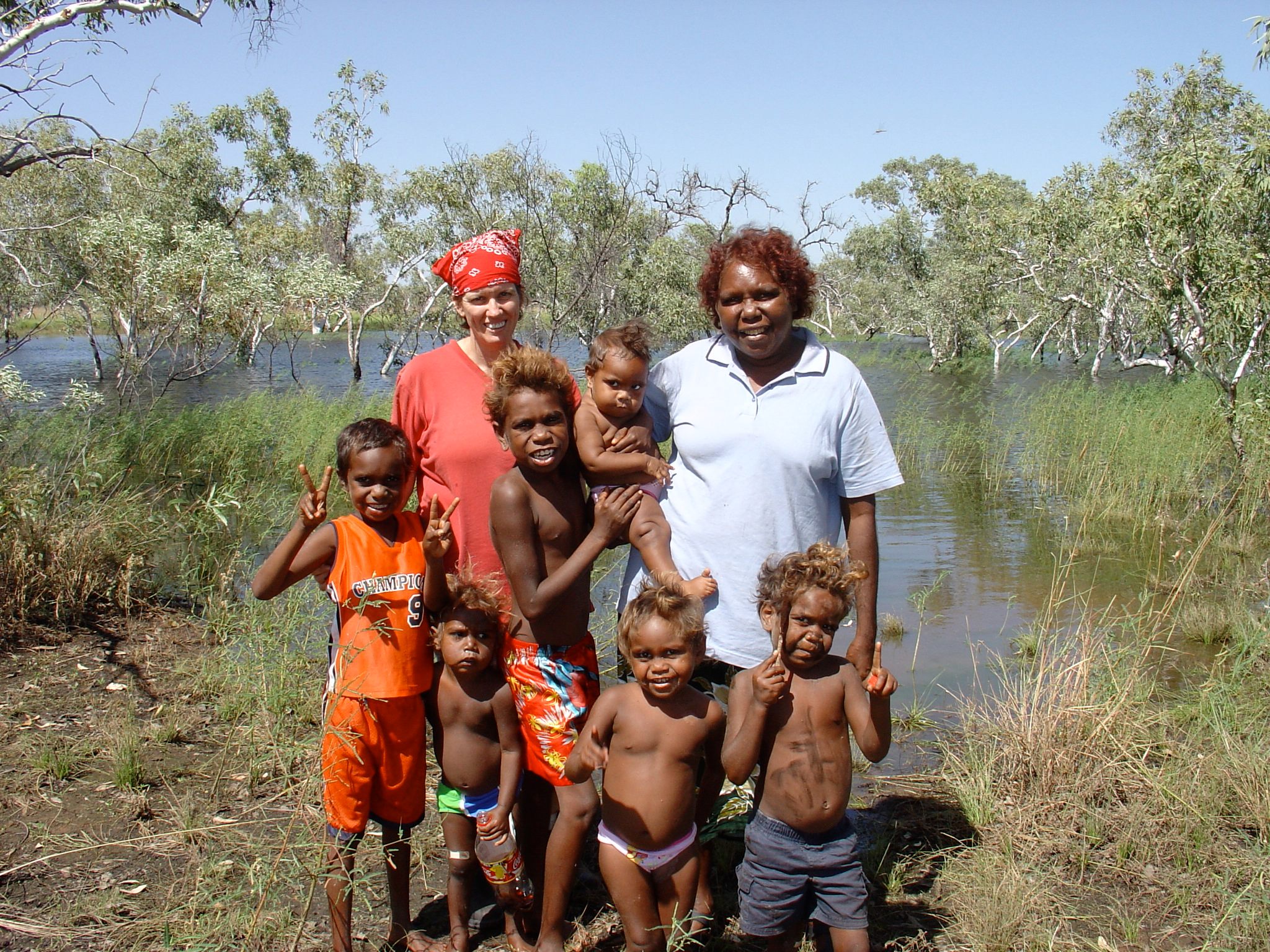Millennial Aboriginal Australians Have Developed Their Own Language
Spoken by Warlpiri under 35, it emerged from code-switching in one remote community.

Millennials, in a way, are a firmly bilingual group, thanks in no small part to “textspeak.” With the rise of Web 2.0 at the turn of 21st century, instant messaging slang and the bevy of acronyms that resulted have become a de facto marker of age, if not cool-factor. Down under, in the remote village of Lajamanu located in Australia’s Northern Territory, recent generations of Indigenous Australian Warlpiri people have created a language much less ubiquitous. Light Warlpiri, a mixed language no more than 40 years old, is spoken almost exclusively by people aged 35 and younger.
Light Warlpiri is made up of a triumvirate of languages: Warlpiri, the indigenous one, Standard Australian English, the colonial one, and Kriol, the English-lexified creole. This blend makes its status as a “mixed language” plain. “Most of the verbs and the grammatical patterns that go along with verbs are from Kriol and English,” says linguist Dr. Carmel O’Shannessy. “And most of the grammatical patterns that go along with nouns are from Warlpiri.” O’Shannessy is Light Warlpiri’s definitive researcher, whose work with the language began as part of her PhD research over a decade ago.
“From 1998-2001 I was living and working in Lajamanu community, not doing any research, but supporting the teaching of Warlpiri in the school’s bilingual education program in Warlpiri and English,” she says. “I heard a lot of what I thought was code-switching [alternating between languages according to who they were speaking with] … and thought that it was interesting.” With the community’s permission, O’Shannessy began researching the way young people were talking as part of her PhD. In 2003, she realized they had developed their own language by systematically melding elements from the two languages they grew up with.

“For a mixed language to develop you have to have bilinguals or multilinguals, who code-switch a lot, in a very systematic pattern, and who have some kind of social reason to create their own way of speaking,” says O’Shannessy. “Code-switching doesn’t usually lead to this kind of outcome, it’s fairly rare.”
O’Shannessy is now based at Australian National University in Canberra, and has visited the Warlpiri community of Lajamanu several times since. “The language is split down the middle, with verbs on one side and nouns on the other,” she says. “This is pretty interesting because there are not many ways of speaking in the world that have this split pattern between nouns and verbs.”
It’s not entirely clear why Light Warlpiri developed in Lajamanu when it did, but through linguistic research, scholars have been able to gather how it did. The most prevalent theory is that Light Warlpiri emerged from gaps in understanding between generations within the Warlpiri community. “Adults were code-switching between Warlpiri, the traditional language, and English and Kriol, a relatively new language,” O’Shannessy says. “Kriol is a creole language that was created in north Australia from 1908 on, and has most words from English but most grammar and the sound system from Indigenous languages. Somewhat like the creoles in the Caribbean and some of the U.S.”
When the code-switching adults were raising their children during the 1970s and ‘80s, things got even more layered. When speaking to young kids, adults “dropped in pronouns and verbs from English and Kriol into the middle of Warlpiri sentences,” says O’Shannessy. “Those little kids processed this as one language, not as switching between languages. They added in some new grammatical patterns, that come from the other languages but are not the same, and then they had their own, new way of speaking.” For the younger generation, this adult method of speaking didn’t register as code-switching, but instead as its own language, the language that would become their language, Light Warlpiri.

The term code-switching is often applied to the verbal volleying many Black Americans participate in; in some environments, like majority-white workplaces, standard American English is most “appropriate,” and in others, like family barbecues or church services, African American Vernacular English (AAVE) becomes more fitting. The reasons behind this oscillation between two different but identifiable ways of speaking are numerous, and Light Warlpiri operates similarly. Socially, code-switching functions as a way “to signal ourselves as members of one group versus another,” says O’Shannessy. Additionally, it can be employed to “add flavor to our conversation,” and “when the meaning we want to express does not have an exact translation in the other language.” Early Light Warlpiri speakers likely drew upon all three factors when using the language. But young members of the community simply grew up with it as a dominant way of talking and so as they conventionalized it over time, it became a “[signal] for being young and from that community.”
In the 1920s, the Australian government began forced migration of select Warlpiri people to Lajamanu. Before contact with Europeans, the Warlpiri were hunter-gatherers. The Lajamanu community was ultimately established in 1948, at a place then known as Hooker Creek. Prior to this, the land belonged to a neighboring indigenous community called the Gurindji people. “But the government didn’t recognize Aboriginal land ownership so they considered it to be vacant,” O’Shannessy adds.
Lajamanu is remote; the nearest town is 600 kilometers (373 miles) away. In the mid-20th century, lives were in flux, and “[people] were also working for no pay, just rations, with no choice of work and very little agency in their lives. Their lives were run by the government, they were not free to travel or live or work where they wanted to,” O’Shannessy says. Having to start fresh outside of the comfort of relatives, these Warlpiri people were doubly isolated, both from city centers and kin. O’Shannessy says that this remoteness played a role. “Now everyone can talk to each other regularly on a cell phone, but it wasn’t like that in the 1950s–1990s.”
The small size of this particular town allowed for the rapid sharing of a new language like Light Warlpiri because it was common for everyone to see each other on a daily basis, “so a new way of speaking could quickly spread through the friendship groups of the children, and stop at the boundary of the community.” The rapid migration of Warlpiri people to Lajamanu was mirrored in the development of this new language. “With all of this forced change in people’s lives, how they used their languages suddenly had to change also. For example, they suddenly had to talk to people whose languages they didn’t know, which is how Kriol developed.”*
Today, it’s estimated that between 350 and 450 people speak Light Warlpiri (which, it should be noted, is not the whole of the village. According to a 2016 census, the total population was 606, but the community has grown since.) The Warlpiri language is spoken by everyone, but the multilingual older millennials who speak regular Warlpiri, plus English, some Kriol, and Light Warlpiri too, represent the cohort of people who created the mixed language and passed it down to their children. These multilingual members of Lajamanu choose to use Light Warlpiri as their main way of talking as a signal for “being young and from this community,” O’Shannessy explains.

Just because a language exists doesn’t mean it’s yet written, and Light Warlpiri serves as confirmation of this. As it stands, the language is purely verbal because, O’Shannessy says, “the community and I haven’t yet worked out a spelling system.” This will remain the case until the Warlpiri demonstrate that they even want to formally document their language. (The importance of Dr. O’Shannessy’s work is exemplified by the fact that she has been able to track a language in its infancy, rather than upon its imminent death; the fact that Light Warlpiri’s first speakers are still living is another boon.) By contrast, the researcher notes, “Warlpiri is written, and has been for some time, and is used in the school and the church and some public documents.”
Since Light Warlpiri’s first official speakers were very young children, and since the language has only been alive for roughly four decades, the matriculation from verbal use to literary use might take time. In true millennial fashion, however: “People do write on social media, but not yet with a conventionalized way of spelling.” As it turns out, Instagram captions may emerge as a definitive 21st century archive—the bridge between a new language being verbally communicated and officially documented.
*Correction: The story originally said that there is no future tense in Light Warlpiri. This is not the case.








Follow us on Twitter to get the latest on the world's hidden wonders.
Like us on Facebook to get the latest on the world's hidden wonders.
Follow us on Twitter Like us on Facebook